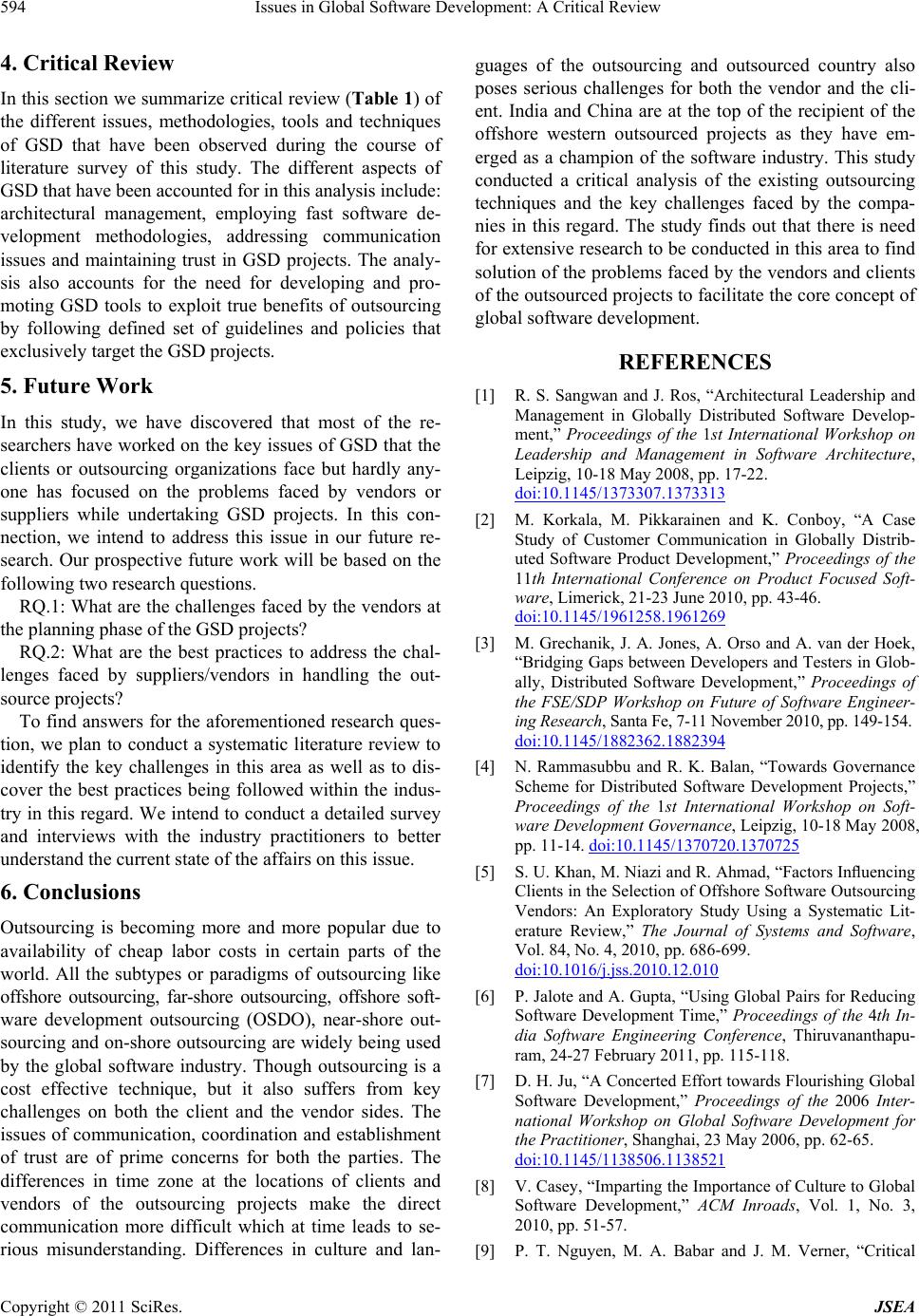
Issues in Global Software Development: A Critical Review
Copyright © 2011 SciRes. JSEA
594
4. Critical Review
In this section we summarize critical review (Table 1) of
the different issues, methodologies, tools and techniques
of GSD that have been observed during the course of
literature survey of this study. The different aspects of
GSD that have been accounted for in this analysis include:
architectural management, employing fast software de-
velopment methodologies, addressing communication
issues and maintaining trust in GSD projects. The analy-
sis also accounts for the need for developing and pro-
moting GSD tools to exploit true benefits of outsourcing
by following defined set of guidelines and policies that
exclusively target the GSD projects.
5. Future Work
In this study, we have discovered that most of the re-
searchers have worked on the key issues of GSD that the
clients or outsourcing organizations face but hardly any-
one has focused on the problems faced by vendors or
suppliers while undertaking GSD projects. In this con-
nection, we intend to address this issue in our future re-
search. Our prospective future work will be based on the
following two research questions.
RQ.1: What are the challenges faced by the vendors at
the planning phase of the GSD projects?
RQ.2: What are the best practices to address the chal-
lenges faced by suppliers/vendors in handling the out-
source projects?
To find answers for the aforementioned research ques-
tion, we plan to conduct a systematic literature review to
identify the key challenges in this area as well as to dis-
cover the best practices being followed within the indus-
try in this regard. We intend to conduct a detailed survey
and interviews with the industry practitioners to better
understand the current state of the affairs on this issue.
6. Conclusions
Outsourcing is becoming more and more popular due to
availability of cheap labor costs in certain parts of the
world. All the subtypes or paradigms of outsourcing like
offshore outsourcing, far-shore outsourcing, offshore soft-
ware development outsourcing (OSDO), near-shore out-
sourcing and on- shore outsourcing are widely being used
by the global software industry. Though outsourcing is a
cost effective technique, but it also suffers from key
challenges on both the client and the vendor sides. The
issues of communication, coordination and establishment
of trust are of prime concerns for both the parties. The
differences in time zone at the locations of clients and
vendors of the outsourcing projects make the direct
communication more difficult which at time leads to se-
rious misunderstanding. Differences in culture and lan-
guages of the outsourcing and outsourced country also
poses serious challenges for both the vendor and the cli-
ent. India and China are at the top of the recipient of the
offshore western outsourced projects as they have em-
erged as a champion of the software industry. This study
conducted a critical analysis of the existing outsourcing
techniques and the key challenges faced by the compa-
nies in this regard. The study finds out that there is need
for extensive research to be conducted in this area to find
solution of the problems faced by the vendors and clients
of the outsourced pro jects to facilitate the core con cept of
global software development.
REFERENCES
[1] R. S. Sangwan and J. Ros, “Architectural Leadership and
Management in Globally Distributed Software Develop-
ment,” Proceedings of the 1st International Workshop on
Leadership and Management in Software Architecture,
Leipzig, 10-18 May 2008, pp. 17-22.
doi:10.1145/1373307.1373313
[2] M. Korkala, M. Pikkarainen and K. Conboy, “A Case
Study of Customer Communication in Globally Distrib-
uted Software Product Development,” Proceedings of the
11th International Conference on Product Focused Soft-
ware, Limerick, 21-23 June 2010, pp. 43-46.
doi:10.1145/1961258.1961269
[3] M. Grechanik, J. A. Jone s, A. Orso and A. van der Hoek,
“Bridging Gaps between Developers and Testers in Glob-
ally, Distributed Software Development,” Proceedings of
the FSE/SDP Workshop on Future of Software Engineer-
ing Research, Santa Fe, 7-11 November 2010, pp. 149-154.
doi:10.1145/1882362.1882394
[4] N. Rammasubbu and R. K. Balan, “Towards Governance
Scheme for Distributed Software Development Projects,”
Proceedings of the 1st International Workshop on Soft-
ware Development Governance, Leipzig, 10-18 May 2008,
pp. 11-14. doi:10.1145/1370720.1370725
[5] S. U. Khan, M. Niazi and R. Ahmad, “Factors Influencing
Clients in the Selection of Offshore Software Outsourcing
Vendors: An Exploratory Study Using a Systematic Lit-
erature Review,” The Journal of Systems and Software,
Vol. 84, No. 4, 2010, pp. 686-699.
doi:10.1016/j.jss.2010.12.010
[6] P. Jalote and A. Gupta, “Using Global Pairs for Reducing
Software Development Time,” Proceedings of the 4th In-
dia Software Engineering Conference, Thiruvananthapu-
ram, 24-27 February 2011, pp. 115-118.
[7] D. H. Ju, “A Concerted Effort towards Flourishing Global
Software Development,” Proceedings of the 2006 Inter-
national Workshop on Global Software Development for
the Practitioner, Shanghai, 23 May 2006, pp. 62-65.
doi:10.1145/1138506.1138521
[8] V. Casey, “Imparting the Importance of Culture to Global
Software Development,” ACM Inroads, Vol. 1, No. 3,
2010, pp. 51-57.
[9] P. T. Nguyen, M. A. Babar and J. M. Verner, “Critical